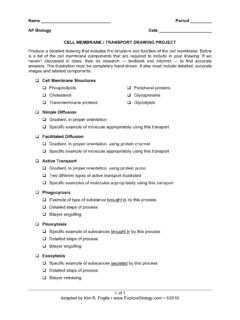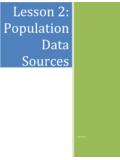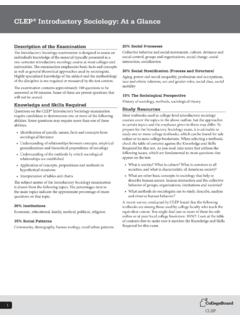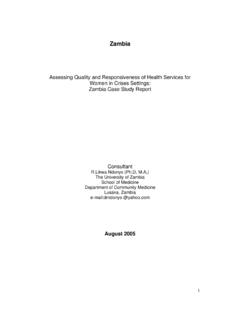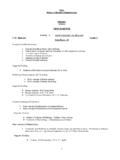Transcription of Chapter 52
1 2004-20051 Half Hollow Hills High SchoolMs. FogliaAP Biology2004-2005AP BiologyPopulation EcologyChapter 522004-2005AP BiologyEssential Questions How do we measure a population ? How do populations change over time? What factors affect population density,distribution & age structure? What are the limits to growth of apopulation? How many humans canthe Earth support?2004-20052 Half Hollow Hills High SchoolMs. FogliaAP Biology2004-2005AP BiologyPopulations population group of individuals of same species insame general area rely on sameresources interact interbreed2004-2005AP BiologyFirst measuredensity & dispersionWhat environmentalfactors affect apopulation?
2 population Ecology population Ecology study of populations in relation toenvironment environmental influences on populationdensity & distribution, age structure,and variations in population size2004-20053 Half Hollow Hills High SchoolMs. FogliaAP Biology2004-2005AP BiologyPopulation density How do we measure how manyindividuals in a population ? number of individuals in an area mark & recapture methodsHow does this work?Difficult to count a moving target2004-2005AP BiologyPatterns of Dispersal Spacing patterns within a populationProvides insight into theenvironmental associations& social interactions ofindividuals in population2004-20054 Half Hollow Hills High SchoolMs.
3 FogliaAP Biology2004-2005AP BiologyClumped Pattern (most common)2004-2005AP BiologyUniformClumped patternsmay result from directinteractions betweenindividuals in thepopulation2004-20055 Half Hollow Hills High SchoolMs. FogliaAP Biology2004-2005AP BiologyChanges topopulation size Adding &removingindividuals from apopulation birth death immigration emigration2004-2005AP BiologyWhat doesthis tell youabout thepopulation?Demography Factors that affect growth & decline ofpopulations vital statistics & how they change overtimeLife table2004-20056 Half Hollow Hills High SchoolMs.
4 FogliaAP Biology2004-2005AP BiologySurvivorship curves Graphic representation of life tableBelding ground squirrelThe relatively straight lines of the plots indicate relatively constant rates ofdeath; however, males have a lower survival rate overall than BiologySurvivorship curves What does this tell about survival & strategyof a species2004-20057 Half Hollow Hills High SchoolMs. FogliaAP Biology2004-2005AP BiologyReproductive Table Fertility schedule age-specific summary of reproductiverates for females2004-2005AP Biologymaximum rate =intrinsic rate of increasePopulation growthchange in population = births deaths Exponential model (ideal conditions)dN = rmaxNdtN= # of individualsr= rate of growtht= time periodgrowth increasing at constant rate2004-20058 Half Hollow Hills High SchoolMs.
5 FogliaAP Biology2004-2005AP BiologyExponential growth rate Characteristic of populationsintroduced to a new environment orrebounding from a catastropheAfrican elephantprotected from huntingWhooping cranecoming back from near extinction2004-2005AP BiologyCarrying capacity Can populations continueto grow exponentially? Of course NOT! What sets limit? Carrying Capacity (K) maximum populationsize that environmentcan support with nodegradation of habitat not fixed; varies withchanges in resources2004-20059 Half Hollow Hills High SchoolMs.
6 FogliaAP Biology2004-2005AP BiologyLogistic model of growth2004-2005AP BiologyLogistic model of growth2004-200510 Half Hollow Hills High SchoolMs. FogliaAP Biology2004-2005AP BiologyLife history traits K-selection = density dependent r-selection = maximize reproductive successK-selectionr-selectionmortality constant2004-2005AP BiologyTrade offsNumber & size of offspringor parent2004-200511 Half Hollow Hills High SchoolMs. FogliaAP Biology2004-2005AP BiologyParental survivalThe cost of largerbroods to bothmale & femaleparents2004-2005AP BiologyRegulation of population size Limiting factors density independent environmental disturbances density dependent food supply competition predators population cycles populationfluctuations Dungeness crabsocean currents & cannibalism 2004-200512 Half Hollow Hills High SchoolMs.
7 FogliaAP Biology2004-2005AP BiologyLimits to growth Negative feedback prevents unlimitedgrowthDensity dependent death raterises as birth rate risesDensityindependentdeath rate orbirth rateWhat does it mean to be densitydependent or density independent?2004-2005AP BiologyLoss of habitat, predation, climatic changes affecting food availabilityPopulation dynamics Complex interaction of biotic & abioticinfluencesDecline of Northern Pintail2004-200513 Half Hollow Hills High SchoolMs. FogliaAP Biology2004-2005AP BiologyIsle Royale studiesMoose population on small island in Lake SuperiorWhy so unstable?
8 Wolvesstarvationwinter loss2004-2005AP BiologyPredator prey interactions population cycles2004-200514 Half Hollow Hills High SchoolMs. FogliaAP Biology2004-2005AP BiologyHuman populationWhat factors have contributed tothis exponential growth pattern?1650 500 million2005 6 billion2004-2005AP BiologyHuman population : rate of growthPercent increase inglobal humanpopulation (to 2003).Dashed portion ofcurve indicatesprojected data. Sharpdip in 1960s is duemainly to a famine inChina in which ~ 60million people Hollow Hills High SchoolMs.
9 FogliaAP Biology2004-2005AP BiologyDemographic comparisonsWhat do the data implyabout population growthin these countries?2004-2005AP BiologyAge structure Relative number of individuals of each ageWhat do the data imply about population growth inthese countries?2004-200516 Half Hollow Hills High SchoolMs. FogliaAP Biology2004-2005AP BiologyImpact: Ecological FootprintIs the human populationnear carrying capacity?Based on land & water areaappropriated to produce allresources it consumes & toabsorb all wastes it generatesdeficitsurplusK = 10 15 billion?
10 2005 = ~6 billio

